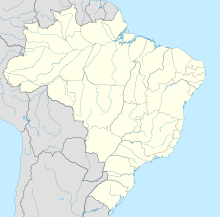Manaus International Airport
|
Manaus International Airport - Eduardo Gomes Aeroporto Internacional de Manaus - Eduardo Gomes |
|||||||||||
|---|---|---|---|---|---|---|---|---|---|---|---|
 |
|||||||||||
| Summary | |||||||||||
| Airport type | Public | ||||||||||
| Operator | Infraero | ||||||||||
| Serves | Greater Manaus | ||||||||||
| Location | Amazonas, Brazil | ||||||||||
| Focus city for | Azul Brazilian Airlines | ||||||||||
| Elevation AMSL | 80 m / 264 ft | ||||||||||
| Coordinates | 03°02′28″S 060°03′02″W / 3.04111°S 60.05056°WCoordinates: 03°02′28″S 060°03′02″W / 3.04111°S 60.05056°W | ||||||||||
| Website | http://www4.infraero.gov.br | ||||||||||
| Map | |||||||||||
| Location in Brazil | |||||||||||
| Runways | |||||||||||
|
|||||||||||
| Statistics (2016) | |||||||||||
|
|||||||||||
|
Statistics: Infraero
Sources: Airport Website,ANAC |
|||||||||||
| Passengers | 2,651,452 |
|---|---|
| Aircraft Operations | 37,951 |
| Metric tonnes of cargo | 113,861 |
Manaus International Airport - Eduardo Gomes (IATA: MAO, ICAO: SBEG) is the major international airport in Northern Brazil, located in the city of Manaus and the busiest in the number of international passengers this region. In cargo transport, it is the third busiest in the Brazil, behind only the airports of Guarulhos and Viracopos.
It is named after the Brazilian politician and military figure Air Marshal Eduardo Gomes (1896–1981). It is located in the west of Manaus, 8 miles (13 km) from the historic center.
Manaus International Airport replaced Ponta Pelada Airport as the main public airport of Manaus in 1976. Ponta Pelada was then given the name Manaus Air Force Base and began handling exclusively military operations.
The construction of the airport began in 1972 and it was officially inaugurated on 31 March 1976. It was then the most modern airport in Brazil and the first one to operate with jet bridges. Though originally planned to be named Supersonic Airport of Manaus, it had its official name changed to Eduardo Gomes by the law 5.967 of 11 December 1973.
The airport has two passenger terminal buildings. Passenger Terminal 1 receives domestic and international flights and Passenger Terminal 2, opened on 12 March 1985, receives general aviation and some regional flights. Furthermore, the airport has three cargo terminals, opened in 1976, 1980 and 2004. They have a total area of 49,000 m² and can process up to 12,000 t/month of cargo. Cargo Terminals 1 and 2 handle goods for export and Cargo Terminal 3 for import.
The Brazilian Integrated Air Traffic Control and Air Defense Center section 4 (Cindacta IV) is located in the vicinity of the airport.
...
Wikipedia

